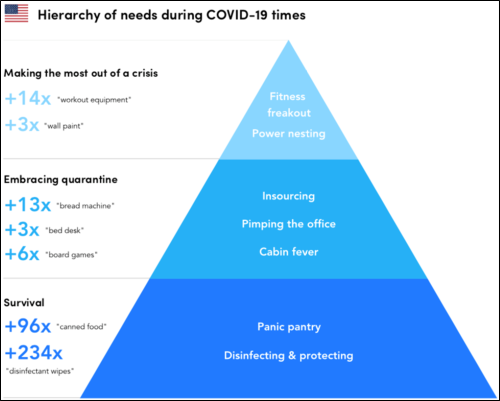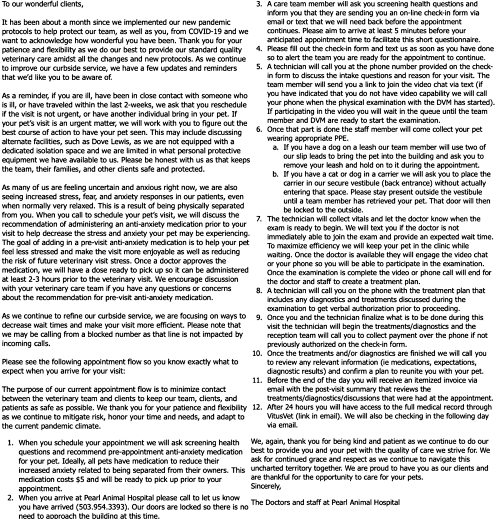7 more tips for writing during the pandemic
Here are 7 more tips on writing during the Covid-19 pandemic — or any other crisis.
1. Which type of Quarantined Consumer are you?
Move over, Maslow. There’s a new hierarchy of needs for these times.

Based on Amazon search terms, the eCommerce firm Profitero has come up with a list of 7 types of quarantined consumers, represented in this hierarchy of needs:
- Power nesting. They’re channelling their inner Marie Kondos, looking to make their homes happier, cozier and more exciting. Searches: gardening equipment, paint, plants, storage containers.
- Insourcing. They’re learning to live without their daily java run and lunches out to become DIYers in the kitchen. Searches: air fryers, bread machines, pizza ovens.
Your readers may be down a few rungs on Maslow’s Hierarchy of Needs these days. If they’re worrying about safety, food and toilet paper, they’re probably not too focused on self-actualizing.
- Pimping the office. They accept the new virtual reality of work and look to optimize their home offices. Searches: bed desks, chair massagers, headsets.
- Cabin fever. They’re confronting the loneliness and boredom of being stuck at home while keeping the kids entertained. Searches: alcohol, board games, sweat pants.
- Panic pantry. They’re in survival mode, stocking up on essential supplies. Searches: bottled water, canned food and pasta.
- Disinfecting & protecting. They’re feeling germaphobic, wanting to do everything they can to prevent contagion. Searches: cleaners, hand sanitizers, and cold and flu medicine.
As you work to reach your readers with compassionate, reader-centric messages during the pandemic, this might be a useful tool for targeting readers where they are.
Remember: Your readers may be down a few rungs on Maslow’s Hierarchy of Needs these days. If they’re worried about safety, food and toilet paper, they’re probably not too focused on self-actualizing. Position your message with that in mind.
How can you Think Like a Reader to position every message in your readers’ best interest? Find out at our Catch Your Readers Master Class.
2. Write like Andrew Cuomo, Part 2.
 New York Gov. Andrew Cuomo is offering a free Master Class to anyone who wants to learn how to write during a crisis or craft confident executive communications. All you have to do is watch him.
New York Gov. Andrew Cuomo is offering a free Master Class to anyone who wants to learn how to write during a crisis or craft confident executive communications. All you have to do is watch him.
Last week, we looked at Cuomo’s Twitter feed, a textbook of clear communications. This week, let’s turn to his quotes, like these, in response to Senate Majority Leader Mitch McConnell’s suggestion that states file for bankruptcy:
The remarks drew a caustic reaction from Gov. Andrew M. Cuomo of New York, who called the bankruptcy suggestion “one of the saddest, really dumb comments of all time.”
— New York Times
“That’s how you’re going to bring this national economy back?” asked an incredulous Mr. Cuomo, who called Mr. McConnell irresponsible and reckless. “You want to see that market fall through the cellar? Let New York State declare bankruptcy.”
— New York Times
“What he’s saying is when you look at the states that have coronavirus problems, they tend to be Democratic states,” Cuomo said. “How ugly a thought — I mean just think of what he’s saying. People died. 15,000 people died in New York, but they were predominantly Democrats, so why should we help them?”
— ABC News
What makes these quotes so effective? They:
- Put the “bite” in the sound bite — “a maximum of bite to a minimum of sound,” as Mark Twain once counseled. Don’t waste a word.
- Sound like a real person said them, not that they’d gone through multiple rounds of approvals and revisions. Think passion and personality.
- They’re colorful and creative, and that makes them memorable.
How can you turn your lame-ass quotes into killer bites? Find out at our PR-writing workshop.
3. Help readers skim.
I received this Covid-19 email update today from my fur babies’ favorite doctor at Pearl Animal Hospital.
 The problem: Dr. McSweety wanted me to read this full, 1,200-word scroller!
The problem: Dr. McSweety wanted me to read this full, 1,200-word scroller!
People don’t read, Dr. McSweety. They scan. Especially online. Especially when they’re suffering an infodemic of Covid-19 updates.
Solution: Lift ideas off the screen by encapsulating key messages in subheads, callouts, highlighted key words and other pieces of display copy.

For starters, if you have a list, add bold-faced lead-ins to each item to make the parts of the list skimmable. Then add a subhead to the top of the list to make the whole list understandable. That will transform your list into a free-standing information package.
How can you lift your ideas off the screen to reach even non-readers with display copy? Find out at our Reach Readers Online Master Class.
4. How long are your sentences?
Add a word to your sentence, and you’ll reduce comprehension. Add another one, reduce it even further. Add another one and reduce it even more.
Add another one and reduce it even more.
There’s a one-to-one correlation between sentence length and understanding, according to research by the American Press Institute.
That’s important every day. But it’s even more important during a pandemic because:
- Clutter looks like obfuscation. Trying to hide the fact that your organization is holding giant conferences despite stay-at-home orders; taking SBA loans meant for small, struggling businesses; or instructing employees not to wash their hands? Hide it in long sentences, paragraphs or words. Conversely, write long sentences, paragraphs or words, and readers will start to wonder what you’re hiding.
- Readers are using their cognitive resources elsewhere. They’re worried about health and safety, keeping the kids entertained and getting out the next round of Covid-19 updates. They don’t have time to parse your sentence to figure out what you’re trying to say.
- We’re living in an infodemic. Literally, every person and organization in the world is affected by Covid-19. That’s a lot of email. The messages that get through will be reader focused and easy to read.
How can you make every message you write easier to read and understand? Find out at our Rev Up Readability Master Class.
5. Coin a word.
I had a cruffin for breakfast this morning. My sister writes a blog about our mother, which makes her a momoirist. I’ve been pretending to work hard; it’s been a whole week of fauxductivity.
 Oh, how I love portmanteaus, or half-and-half words. They grab attention, shed new light on your product or program and make your message easy to remember.
Oh, how I love portmanteaus, or half-and-half words. They grab attention, shed new light on your product or program and make your message easy to remember.
The coronavirus pandemic has spawned (or reminded us of) a couple of portmanteaus:
- Infodemic: an overabundance of information that makes it hard for people to find the right information when they need it — World Health Organization.
- Screenout: a new form of burnout; the exhaustion of being on videoconference — The New York Times.
How can you coin your own words — and otherwise surprise and delight readers with wordplay? Find out at our Master the Art of the Storyteller Master Class.
6. Are you skipping a key step in the creative process?
Have you ever come up with a brilliant idea — on the way home from the brainstorming meeting? Developed a creative theme for the annual report while pulling weeds? Written the perfect headline in the shower?
 Welcome to the wonderful world of the creative process, where working sometimes doesn’t look like working, and where sticking with it is often the worst thing you can do to move ahead.
Welcome to the wonderful world of the creative process, where working sometimes doesn’t look like working, and where sticking with it is often the worst thing you can do to move ahead.
To make the most of every writing minute in your day, use a process that works with — not against — your brain.
The third step of this process: incubation. That’s where you take a walk, take a nap, take a break — and nurture your ideas by not working on your project. It’s the most overlooked (and possibly the most essential) of all five steps.
Want to polish your process? Master all of the steps in the creative process at our How to Write Better, Easier & Faster Master Class.
7. The three most powerful words in the English language …
I don’t know.
I’ll bet you’re saying that a lot these days. Unless you can read the future — and if you can, let’s talk! — you don’t know what you’ll be doing next month, next week, tomorrow.
— and if you can, let’s talk! — you don’t know what you’ll be doing next month, next week, tomorrow.
I don’t know doesn’t look weak. It’s a power tool of confident executive communications, especially during a crisis.
I’ve been saying I don’t know a lot to the folks who’ve bought tickets to our Master Classes.
I do know that we’re holding online versions of all of our Master Classes. And I know that we’d be happy to switch your on-site event ticket to an online event, if you prefer.
As for the on-site workshops, we do plan to hold them unless ordered not to. I don’t know when we’ll know for sure, but I do promise to let you know as soon as we get guidance from the states where we’re planning to meet.
That I do know.
What do you need from me during the pandemic? Please hit reply to email me your questions, examples and ideas, I’ll try to address them in the next issue.
See you next week!
P.S. Check out these Covid-19 communication tools …

- I’ll be sharing my tips on How to write during Covid-19 with crisis communication guru Molly McPherson’s podcast on April 27. And check out Molly’s free Covid-19 communication response kit.
- Upskill during your downtime with our online Master Classes.
- Covid-19 resources from IABC
- Crisis communications resources from PRSA
- Daily coronavirus updates from PR News
- Don’t mention the virus! And other marketing tips. What NOT to do when marketing during the pandemic, from The New York Times
- How to Write During Covid-19. Watch this webinar from PRSA and me free with coupon code WYLIE420.